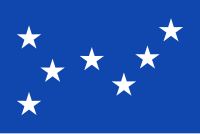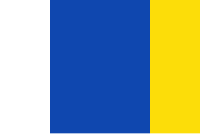Canarian nationalism
This article needs additional citations for verification. (February 2008) |

Canarian nationalism is a political movement that encourages the national consciousness of the Canarian people. The term includes several ideological trends, ranging from the right to self-determination (and complete independence from Spain) to a demand for further autonomy within Spain.
Self-government through history
The origin of Canarian people as it is known now started with the Spanish conquest of the islands, when the local guanche population was defeated and eventually assimilated and European-style manorialism introduced in most of the islands.
During the last days of the conquest, on May 30, 1481, a Guanche leader from Gran Canaria called Tenesor Semidán (afterwards baptized as Fernando Guanarteme) signed a peace treaty with Ferdinand II of Aragon, in the so-called Carta de Calatayud. This treaty defined the archipelago as a kingdom within the Spanish monarchy, establishing the legal framework for its administration and its relationship with Spain.
The pact signed in Calatayud granted the rights and duties that would shape the Canarian fuero (Fuero de Canarias), which would soon be utilized in institutions such as the Cabildos and the Canarian Court (Audiencia de Canarias). Notable rights stated in the fuero included an autonomous treasury and army, and the continuity of traditional Canarian customs and roles. The Canary Islands had its own currency until 1776.
Initially only Gran Canaria accepted the pact, but one by one the whole archipelago eventually consented to the agreement.
Spain failed to fulfill the pact several times, a failure that resulted in the uprisings of 1502 (Ichasagua), 1770 (La Aldea), and 1778 (Arico).
The pact was finally discarded during the Restoration.

Beginnings of organized nationalism
The first nationalist organizations were born in the nineteenth century as part of a local labour movement. Some of its proponents were José Cabrera Díaz, Nicolás Estévanez and Secundino Delgado. Delgado is considered today as the father of the Canarian nationalism.
The earliests nationalists parties was the Partido Popular (Autonomista), founded in 1901 in Santa Cruz de Tenerife, and the Canarian Nationalist Party, founded in 1924 in exile in Cuba.
During the Second Spanish Republic Canarian nationalism went unnoticed; although an autonomy statute was proposed, the Spanish Civil War blocked hopes for autonomy.


During the dictatorship
Francoism fiercely oppressed any kind of nationalism in Spain and its colonies. However, the 1960s were years known for the activism of various groups. In 1959 the movement Canarias Libre acquired some notoriety, and in 1964, Antonio Cubillo founded the MPAIAC (Movement for the Self-determination and Independence of the Canarian Archipelago). The MPAIAC created the flag of the seven green stars that is accepted by the nationalist movement as a whole today.
During the last days of Francoism, the final decay of Canarian nationalism was preceded by some terrorist acts committed by the DAC (Destacamentos Armados Canarios) and the FAG (Fuerzas Armadas Guanches).
Spanish democracy
Since 1982 the Canary Islands have a statute of autonomy, never ratified by the people[citation needed], that defines the archipelago as a historical nationality.
In the 1980s a nationalist-like party called UPC (Canarian People's Union) was the third most voted party in Canary Islands.
Since 1993, the nationalist party Canarian Coalition has held the government of the islands.
Current situtation
Nowadays there are a lot of parties, trade unions and associations of any kind that describe themselves as "nationalist".
Some examples of nationalist parties include CC (Canarian Coalition), NC (Nueva Canarias), CCN (Nationalist Canarian Centre), ANC (Nationalist Canarian Alternative), UP (People's Union).
Some examples of nationalist trade unions include FSOC (Frente Sindical Obrero Canario), IC (Intersindical Canaria).
The movement has recently undergone a modest renaissance. The most popular newspaper in the islands[citation needed], El Día, has changed its editorial line to fit the nationalists' cause. In its pages it is normal to read the opinion of historical nationalist activists. In particular the "Project for a Federal Canarian Republic", written by Antonio Cubillo, has created a stir and a media debate.
External links
Political parties
- Nueva Canarias
- Coalición Canaria
- Centro Canario Nacionalista
- Alternativa Nacionalista Canaria
- Partido Nacionalista Canario
- Unidad del Pueblo
- Alternativa Maga Nacionalista
Media
- El Día
- Canarias Insurgente
- Elguanche.net
- Canarias Nación
- Soberanía
- Sovereignty and colonialism in Canary Islands
Bibliography and references
- Abreu Galindo, ("Que todas las franquezas y libertades que tenían, se le guardarían").
- Historia de La Conquista de las siete Islas de Canaria.
- Ovetense ("y así se le hizo su bautismo con gran solemnidad, como a persona real").
- El pacto para Tenerife, Juan Bethencuort Alfonso, Historia del Pueblo Guanche, tomo III.
- Abreu Galindo
- Juan Bethencuort Alfonso, Historia del Pueblo Guanche, tomo III.
- Luis Pérez Aguado, Revista Aguayro nº 228.
- Pedro Cullen del Castillo, Torre de Gando.
- Juan Bethencuort Alfonso, Historia del Pueblo Guanche, tomo II
- Africo Amasik, El Arbol de La Nación Canaria.
- Hupalupa, Magos, Maúros, Majoreros o Amasik.
- 3.000 años de canariedad, AMAGA, Alternativa Maga Nacionalista.
